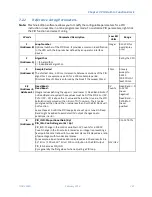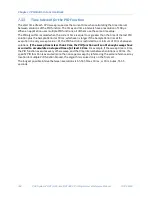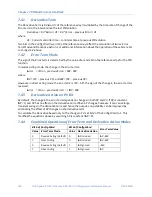
Chapter 7. PID Built-In Function Block
348
PACSystems* RX7i, RX3i and RSTi-EP CPU Programmer's Reference Manual
GFK-2950C
Words
Parameter/Description
Low Bit
Units
Range
7
(6)
PID_IND: Derivative Gain (Kd)
PID_ISA: Derivative Time (Td = Kd)
PID_IND: Change in the control variable in CV Counts if the Error or PV
changes 1 PV Count every 10ms. Entered as an integer representing a
fixed-point decimal time in seconds with two decimal places. The
least significant digit represents 0.01 second (10ms.) units. Displayed
as seconds with two decimal places.
For example, Kd entered as 120 is displayed as 1.20 Sec and results in
a Kd *
Δ
Error / delta time or 120 * 4 / 3 contribution to the PID Output
if Error changes by 4 PV Counts every 30ms. Kd can be used to speed
up a slow loop response, but is very sensitive to PV input noise. This
noise sensitivity can be reduced by using the derivative filter, which is
enabled by setting bit 5 of the
PID_ISA: The ISA derivative time in seconds, Td, is entered and
displayed in the same way as Kd. Total derivative contribution to PID
Output is Kc * Td *
Δ
Error /
dt
.
0.01 sec 0 to 327.67 sec
8
(7)
PID_IND: Integral Rate (Ki)
PID_ISA: Integral Rate (1/Ti = Ki)
PID_IND: Rate of change in the control variable in CV Counts per
second when the Error is a constant 1 PV Count. Entered as an integer
representing a fixed-point decimal rate with three decimal places. The
least significant digit represents 0.001 counts per second, or 1 count
per 0.001 second. Displayed as Repeats/Sec with three decimal
places.
For example, Ki entered as 1400 is displayed as 1.400 Repeats/Sec
and results in a Ki * Error *
dt
or 1400 * 20 * 50/1000 = 1,400
contribution to PID Output for an Error of 20 PV Counts and a 50ms.
CPU sweep time (Sample Period of 0).
PID_ISA: The ISA Integral Time in seconds, Ti, must be inverted and
entered, as integral rate, as described for PID_IND. Total integral
contribution to PID Output is Kc * Ki * Error *
dt
.
Ki is usually the second gain set after Kp.
Repeats/
0.001 Sec
0 to 32.767
repeats/sec
9
(8)
CV Bias/Output Offset
Number of CV Counts added to the PID Output before the rate and
amplitude clamps. It can be used to set non-zero CV values when only
Kp Proportional gains are used, or for feed-forward control of this PID
loop output from another control loop.
CV
Counts
-32768 to
32767
(add to PID
output)
10, 11
(9.
10)
CV Upper Clamp
CV Lower Clamp
Number of CV Counts that define the highest and lowest value that
CV is allowed to take. These values are required. The Upper Clamp
must have a more positive value than the Lower Clamp, or the PID
block will not work. These are usually used to define limits based on
physical limits for a CV output. They are also used to scale the Bar
Graph display for CV. The PID block has anti-reset-windup, controlled
by bit 4 of the Config Word, to modify the integral term value when a
CV clamp is reached.
CV
Counts
-32,768 to
32,767
(Word 10 must
be greater
than word 11.)
Summary of Contents for PACSystems RSTi-EP
Page 357: ......
Page 466: ...Chapter 9 Diagnostics GFK 2950C February 2018 451 ...
















































